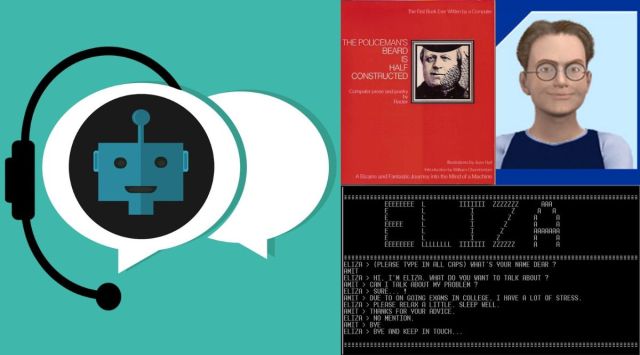Artificial Intelligence technologies are now a rage, especially with OpenAI unveiling ChatGPT, the sensational chatbot which is a Generative Pre-trained Transformer. Within weeks of its release, ChatGPT wowed individuals and organisations with its studious, humanish responses.

 But ChatGPT is certainly not the first ‘chatbot’ that has been created using artificial intelligence tools.
But ChatGPT is certainly not the first ‘chatbot’ that has been created using artificial intelligence tools. A chatbot is, by definition, a computer program designed to simulate a conversation with human users, especially on the internet. What were the chatbots that came before ChatGPT? In fact, where did it all begin? Here w
e attempt to offer a brief history of chatbots from the past.
Story continues below this ad
ELIZA – 1966
ELIZA was a natural language processing program written sometime in the mid-1960s by German-American computer scientist Joseph Wizenbaum at the MIT Artificial Laboratory. Widely acknowledged as the first-ever chatbot, ELIZA used pattern-matching and substitution methods to stimulate conversations. It gave the user the impression it was comprehending inputs; but reportedly there was no mechanism or framework to contextualise.
 Developed at the MIT Artificial Intelligence Laboratory, Eliza was also known as the first artificial therapist.
Developed at the MIT Artificial Intelligence Laboratory, Eliza was also known as the first artificial therapist.
Its creator Wizenbaum, according to reports, really intended to demonstrate the superficiality of interactions between humans and machines. But many who came in contact with ELIZA were convinced about the chatbot’s intellectual prowess.
The chatbot was named after Eliza Doolittle, the protagonist of the play ‘Pygmalion’ by George Bernard Shaw. In the play, Eliza is a flower girl who turns up at a professor’s place to study elocution, and then rises through the ranks of society after she learns its ways. Chatbot ELIZA lived up to its name – it improved over time.
PARRY – 1972
Nearly a decade after ELIZA, another AI chatbot, PARRY, was introduced by psychiatrist Kenneth Colby from Stanford University. Unlike ELIZA, PARRY had a definitive use case. The chatbot was created to simulate a person suffering from paranoid schizophrenia. It did this by implementing a crude model behaviour based on concepts and beliefs. PARRY got a conversational strategy that made it more serious and advanced than ELIZA.
Story continues below this ad
PARRY was put through the Turing Test – also known as the imitation game – to see if it could show intelligent behaviour similar to humans. Two groups of expert psychiatrists were shown transcripts of conversations and asked to identify which of them came from human patients and which from human patients. PARRY fooled them 52 percent of the time. In 1972, PARRY and ELIZA were connected on ARPANET (a predecessor of the Internet), and they talked to each other. The two chatbots were known to have hooked up many times since.
Racter – 1984
Nearly four decades before ChatGPT, an AI computer program wrote a book all by itself. Racter was developed by Mindscape for generating English prose. Believed to have been programmed on one of Apple’s early computers, Racter was developed using minimal resources. Racter authored ‘The Policeman’s Beard is Half Constructed’, published in 1984.
This was how the book introduced its author: “Racter (the name is short for raconteur) is the most highly developed artificial writer in the field of prose synthesis today. Fundamentally different from artificial intelligence programming, which tries to replicate human thinking, Racter can write original work without promptings from a human operator.”
 Cover page of ‘The Policeman’s Beard is Half Constructed’ written by Racter.
Cover page of ‘The Policeman’s Beard is Half Constructed’ written by Racter.
The 129-page-long book comprises poetry, aphorisms, and short stories. Its programmer said Racter needed no input from the outside world. Once it started running , it was just “cooking by itself”.
Story continues below this ad
Mark V. Shaney – 1985
Mark V Shaney, created by Bruce Ellis and Rob Pike, was a text-generating robot. The text was largely gathered from posts on newsgroups. Categorised as an artificial bot for Usenet, the oldest computer network, Mark V Shaney shared posts that bluffed many users into believing that it was human.
Jabberwacky – 1988
British creator Rollo Carpenter introduced in the ’80s Jabberwacky – a chatterbot – which was different from its staid predecessors. Created solely for entertainment, Jabberwacky was designed to mix a dash of drollery in its conversations with humans. Carpenter wanted to integrate chatbots with robots to create what many of us would love to have – a companion with a wacky sense of humour. Jabberwacky wasn known to have relied on an AI method called contextual pattern matching.
Clippy – The Office Assistant – 1997
Although not a chatbot, Office Assistant, fondly known as Clippy, was an intelligent user interface introduced by Microsoft for its Office. It was included in Microsoft Office For Windows 97, and was discontinued after the 2004 version. An interactive animated character was assigned to help users know various Microsoft Office features. One just needed to type ‘Dear’, and Clippy would appear on the screen.
Albert One – 1998
One of the most popular chatterbots in the late ‘90s, Abert One was developed by artist and programmer Robby Gardner to imitate human conversations via natural language programming. In 1998 and 1999, Albert One won the Loebner Prize for the best chatbot. A BBC report published in 1999 said the chatbot’s witty one-liners and quirky questions convinced nearly 11 per cent of people that it was human.
Story continues below this ad
Ultra Hal Assistant – 2000
This chatbot was created to be a personal assistant. Developed by the US-based software company Zabaware Inc in 2000, Ultra Hal comes with a natural language interface, speech synthesis, and animated characters. Users can interact with the chatbot by typing inputs or through its speech recognition engine. The chatbot took its name from the AI named Hal 9000 in Stanley Kubrick’s sci-fi epic ‘2001: A Space Odyssey’.
A.L.I.C.E – 2001
Artificial Linguistic Internet Computer Entity, or ALICE, is a chatbot that processes natural language. Introduced in 2001 by American scientist Richard Wallace, it engages with humans using a heuristic method (a system to learn by itself). Wallace reportedly began working on Alice sometime in 1995 and was joined by close to 500 developers from around the world. The chatbot won the Loebner Prize three times. According to reports, Alice was the inspiration for director Spike Jonze’s science fiction film ‘Her’.
Eugene Goostman – 2001
Developed by three programmers in Saint Petersburg, Russia, in 2001. It’s claimed to have passed the Turing Test. Goostman can hold nearly human conversations. Its biggest USP was that it was modelled on a 13-year-old boy who can’t be expected to know everything and ought to be forgiven for grammar and linguistic errors. One of the developers, Vladimir Veselov, said that they spent a lot of time developing a ‘believable character’.
 The biggest USP of Goostman is that it is modelled as a 13-year-old boy who is expected to make grammar and linguistic errors.
The biggest USP of Goostman is that it is modelled as a 13-year-old boy who is expected to make grammar and linguistic errors.
In 2014, Eugene Goostman passed the Turing Test at the Royal Society in London. During a five-minute long typed-interaction, Goostman convinced 33 percent of the judges that it was human.
Story continues below this ad
SimSimi – 2002
Developed in 2002 by ISMaker, this chatting robot makes interesting conversation. Users just need to tap on the screen to be greeted by Simsimi. Like in many other AI models, Simsimi’s vocabulary expands from inputs by users. The app, however, triggered several controversies because of profanity in its response. Brazil suspended the chatbot in 2018 over accusations of relaying sexual content, death threats, and other bullying tactics.
These above were some of the widely-known chatbots of the past years. Over the last five decades there have been numerous chatbots with a wide range of use cases. Some gave way to newer technology. Others quietly faded into oblivion.




 Developed at the MIT Artificial Intelligence Laboratory, Eliza was also known as the first artificial therapist.
Developed at the MIT Artificial Intelligence Laboratory, Eliza was also known as the first artificial therapist. Cover page of ‘The Policeman’s Beard is Half Constructed’ written by Racter.
Cover page of ‘The Policeman’s Beard is Half Constructed’ written by Racter. The biggest USP of Goostman is that it is modelled as a 13-year-old boy who is expected to make grammar and linguistic errors.
The biggest USP of Goostman is that it is modelled as a 13-year-old boy who is expected to make grammar and linguistic errors.





